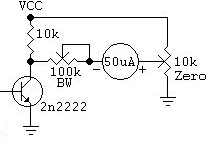neazoi
Advanced Member level 6
Hello, with this little circuit I can point the needle of a meter to a corresponding point, depended on the voltage at the base of the transistor.
In my device, the different needle points, represent different alphabet letters, one letter for each point.
These letters are marked onto the meter panel.
Now what I want, is a way to convert this circuit so it can drive a motor instead.
What I am thinking is a disc of letters, attached to a motor. Depended on the motor voltage, the disc can move clockwise or counterclockwise and stop at the corresponding letter, for the operator to read.
I could just use the needle meter circuit as it is and attach a disc to it, but the weight of the disc will load the delicate meter movement very much, even if it is made out of paper.
Can such a thing be implemented with a motor somehow?
It has to force the motor to go clockwise or counter clockwise and stop it at a point, depended on the input voltage of the driver circuit.
In my device, the different needle points, represent different alphabet letters, one letter for each point.
These letters are marked onto the meter panel.
Now what I want, is a way to convert this circuit so it can drive a motor instead.
What I am thinking is a disc of letters, attached to a motor. Depended on the motor voltage, the disc can move clockwise or counterclockwise and stop at the corresponding letter, for the operator to read.
I could just use the needle meter circuit as it is and attach a disc to it, but the weight of the disc will load the delicate meter movement very much, even if it is made out of paper.
Can such a thing be implemented with a motor somehow?
It has to force the motor to go clockwise or counter clockwise and stop it at a point, depended on the input voltage of the driver circuit.
